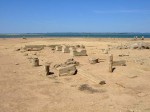 The year of drought in Texas has caused lake and reservoir levels to recede so severely that the remains of ghost towns and graves that have been submerged for decades are now on dry land. Most of the lakes in the state were manmade, created by the construction of hydroelectric and flood control dams, hence the presence of entire towns underwater. With an average rainfall 13 inches below normal for the year, most of the lake levels have dropped over a dozen feet.
The year of drought in Texas has caused lake and reservoir levels to recede so severely that the remains of ghost towns and graves that have been submerged for decades are now on dry land. Most of the lakes in the state were manmade, created by the construction of hydroelectric and flood control dams, hence the presence of entire towns underwater. With an average rainfall 13 inches below normal for the year, most of the lake levels have dropped over a dozen feet.
 The old town of Bluffton, normally under 20 feet of Lake Buchanan, is showing its bones, literal and metaphoric. The gravestone of a little boy, Johnny C. Parks, who died in 1882 just a few days shy of his first birthday, is now in plain view. The remains of the gas station/general store, the grist mill, hotel and cotton gin are now tourist attractions for hikers, as are the rusted hulks of old oil tanks and the town well.
The old town of Bluffton, normally under 20 feet of Lake Buchanan, is showing its bones, literal and metaphoric. The gravestone of a little boy, Johnny C. Parks, who died in 1882 just a few days shy of his first birthday, is now in plain view. The remains of the gas station/general store, the grist mill, hotel and cotton gin are now tourist attractions for hikers, as are the rusted hulks of old oil tanks and the town well.
Local historian Alfred Hallmark, whose great-great-great grandfather helped establish Bluffton, said his research showed 389 graves were moved starting in 1931 when dam construction began. That’s the same year Bluffton’s 40 or 50 residents started moving several miles west to the current Bluffton, which today amounts to a convenience store and post office at a lonely highway intersection serving 200 residents.
Residents had to leave their ranches and abandon precious pecan trees, some of which produced more than 1,000 pounds of nuts each year. “It was devastating,” said Hallmark, 70, a retired teacher, of the move. “They had no choice.”
Some had even fewer choices. This summer an entire children’s cemetery was found under the Richland Chambers Reservoir near Dallas-Ft. Worth. Bones and a single grave had been found before on the shore of the lake, but it wasn’t until the drought that a burial ground containing the graves of 25 children buried before 1890 was discovered. The bones found on the shore dated to around the same time — 100 to 120 years ago — and were consistent with a male of African descent.
A descendant of the 19th century owner of the land that became the reservoir notes that “black people worked for my family and other white families like mine,” meaning her great-grandfather, who moved to Texas from Mississippi in 1866 to start a cotton farm and horse ranch, had sharecroppers living on the property. This might be their cemetery. Archaeologists are working urgently to get the county to fund the full excavation and respectful reburial of the human remains before the drought breaks and the site is resumberged.
 The Lower Colorado River Authority, the non-profit public utility that completed Buchanan Dam after the collapse of the holding company that first fund during the Great Depression, has an incredible collections of pictures from its archives documenting the construction of the dam from 1931 onward on its Flickr page. Go back a page to see their photographic archives of the construction workers’ camp and of the newly relocated Bluffton cemetery with its freshly dug graves. It’s amazing, really, how deep a visual record they’ve kept. Every public utility should upload their archives.
The Lower Colorado River Authority, the non-profit public utility that completed Buchanan Dam after the collapse of the holding company that first fund during the Great Depression, has an incredible collections of pictures from its archives documenting the construction of the dam from 1931 onward on its Flickr page. Go back a page to see their photographic archives of the construction workers’ camp and of the newly relocated Bluffton cemetery with its freshly dug graves. It’s amazing, really, how deep a visual record they’ve kept. Every public utility should upload their archives.
You can see the ruins of Bluffton in this news clip:
[youtube=http://www.youtube.com/watch?v=UKruOOhdyds&w=430]